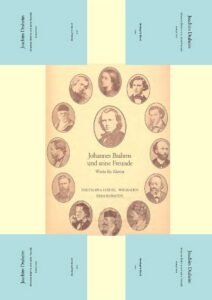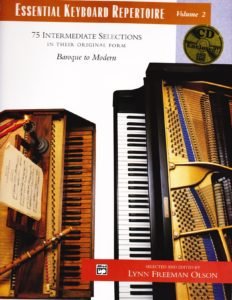Table of Contents:
Johannes Brahms. The titanic fight for symphonic creation and spiritual testimony
We remember the German composer Johannes Brahms (May 7, 1833 – April 3,1897), as the last of the classicists, and the continuer of the tradition of the great German school, in perfect balance with the spirit of romanticism. In response to his status as bearer of the “Beethovenian mantle,” Brahms would write four great Symphonies and a remarkable German Requiem , works that constitute milestones in the history of music.
Please, subscribe to our Library. Thank you!
Why does it take Brahms so long to finish his First Symphony ? The answer lies in the influence that Beethoven exerts on him. The Bonn master casts a shadow over the entire 19th century, as if he were an older brother. Brahms is aware that from very early on he will be identified as Beethoven’s true musical heir. For this reason, he will dedicate the best part of his life to this cause, thus ensuring a symphonic production of the highest level. Beethoven’s composition is admired, studied and canonized, not only by musicians, but also by artists from the most diverse disciplines. Beethoven’s strong character and his image as a liberator of art make him a cry of encouragement for the freest spirit of romanticism.
On the other hand, from the perspective of the 19th century, Beethoven’s vision will gradually be affected by new contemporary values, and the majority of romantic musicians will not recognize the classicism that it contains. However, Brahms is the exception. He is the only musician who understands the classical and romantic balance that Beethoven hides, capturing what other musicians are unable to see. But a simple imitation of genius is not allowed either.
On the contrary, Brahms will invest a large part of his life – twenty-two years – in finding a way to handle the implications of his predecessor and, above all, in being original. Also, he will feel the influence of several romantic composers, such as Schubert, Schumann, Mendelssohn, Berlioz, Chopin and Carl Maria von Weber; and even his “rivals”, Wagner, Liszt, Bruckner. This may explain why Brahmsian classicism is more rational and self-conscious than Beethovenian classicism, in addition to being impregnated with that nostalgic and melancholic spirit that we recognize in his great compositions.
Best Sheet Music download from our Library.
The German musician during his youth. Years later he would be the creator of four formidable symphonies.
Brahms is aware that from very early on he will be identified as Beethoven’s true musical heir. For this reason, he will dedicate the best part of his life to this cause, thus ensuring a symphonic production of the highest level.

Brahms is a somewhat surly character in appearance. He is sometimes kind, affectionate or joking, whenever he meets close people. Although his music may seem somewhat aggressive; Deep down, he is always full of deep lyricism and intense tenderness. As an artist, Brahms does not dare to say everything he feels, just as he resists demonstrating his longing to be loved. His anguish in the face of loneliness will constitute the source of his greatness.
Upon learning of his first compositions, Robert Schumann (1810-1856) pointed to the talented Johannes as the one chosen to “carry Beethoven’s mantle,” despite the fact that the young man was not yet twenty years old, and had not even written for An orchestra. But not much time passes when Brahms takes on the challenge and attempts a symphony in D minor, a work that fails, as he is not yet prepared to tackle this enormous and challenging musical form. Some of his fragments will be incorporated into his later Piano Concerto No.1 (1859), and others into his famous German Requiem (1868). In short, there will be no symphony in D minor, and the genre will have to wait many more years, as Brahms will decide to approach it patiently and gradually. After writing for small orchestra ( Serenades Nos. 1 and 2 in 1873 ), Brahms composed the extraordinary Variations on a Theme by Haydn , and only from this moment on would he feel in a position to begin and conclude a “great” symphony.
The search for perfection.
Symphony No.1 in C minor, op . 68: the terrible conflict
In 1862 some material of the First Symphony already existed. Brahms sends Clara Schumann a sketch of the first movement (even without the famous introduction). Later, in 1868, she sent him a song for her birthday, using the final horn theme. After eight years of intense work, he completes his masterpiece in Lichtental. The premiere took place in Karlsruhe, on November 4, 1876, under the direction of Otto Dessoff. The work manifests a dramatic and agonizing intensity in the opening bars, until reaching supreme confidence in the final coda. It is not easy to capture the dense counterpoint and the rigorous and logical style of the work. The first movement (Un poco sostenuto – Allegro) is procreative in nature. The musical ideas are so close that they merge into a continuity that can be associated with the monothematic. Schoenberg describes it as a technique of “developing variations.” Hermann Levi – after directing the play in Munich (1878) – will comment: “I had never gone through such difficult and afflictive passages.”
In essence, the movement contains that world of Olympic struggle and terrible conflict. An itinerary of struggle, desires and sleepless nights, a reflection of Brahms’ inner life, and his long and introverted process of creation. The second and third movements contain very different worlds from the first. Its duration is brief, as Brahms deliberately reduces the intermediate sections, to unload the immense emotional weight of the entry and exit movements. The ending ( Adagio – Più andante – Allegro non troppo, ma con brio ) contains a long introduction and the vein is close to the chaos that Haydn presents to us at the beginning of The Creation.

In essence, Brahms is not an imitator of Beethoven and his “First Symphony” is an original work, despite adhering to traditional technique and aesthetics.
In the Haydnian Oratorio, the nascent atmosphere dissipates through the cry of Light professed by the choir; in Brahms, however, it dissipates through a calm intervention of the French horn. The Allegro opens with a choral melody that many assimilate to Beethoven’s Ode to Joy and in a way that reminds us of Brahms’ Piano Quintet in F minor , op.34. In short, the First Symphony is recognized as a Beethovenian work. Not in vain, Hans von Bülow nicknamed it “ Beethoven’s Tenth ”, declaring Schumann’s prophecy fulfilled. But Brahms does not share the judgment, and responds irritably: “ Any ass can appreciate that! ”. In essence, Brahms is not an imitator of Beethoven and his First Symphony is an original work, despite adhering to traditional technique and aesthetics.
Symphony No.2 in D major, op.73: Brahms’ “Pastoral”.
The Second Symphony emerges in a burst of inspiration. Not a year has passed since the long-awaited First, when Brahms concludes the work in Wörthersee, in southern Austria, in the summer of 1877. From the place, he writes effusively to a friend: “here the melodies flow so freely that we will have to Be careful not to trample them, and the symphony sounds as tender and joyful as if it were written for a wedding couple!” . There could hardly be a greater contrast between the tense introduction of the First and the feeling of nostalgia and stillness that prevails in the Second. Brahms cultivates a more lyrical vein, compared to other works of this period, such as the first Violin Sonata, Op. 78, and the Concerto for Violin and Orchestra, Op. 77 .
The Second Symphony premiered in Vienna on December 30, 1877, under the direction of Hans Richter, and received a very enthusiastic reception. Just days before the premiere, Brahms comments to his publisher Simrock: “the new symphony is so melancholic that you won’t be able to stand it. I have never written something so sad, and you will see how the score emerges in tears.” Once the performance is over, he will insist: “You should mourn the score, to express the pain that afflicts us!”
“The new symphony is so melancholic that you won’t be able to stand it. I have never written something so sad, and you will see how the score emerges in tears.’
There is a parallel between Brahms’ First and Second symphonies, with Beethoven’s Fifth and Sixth. Beethoven’s Fifth, written in the key of C Minor, is passionate, emotional, but triumphant. Brahms’ First shares tonality and mood with Beethoven’s Fifth. For its part, Brahms’ Second shares mood (but not tonality) with Beethoven’s Sixth. Both are idyllic, although they contain an internal drama. Although Brahms did not allow nicknames for his works, he could not deny that his Second Symphony could be called “Pastoral.” On the other hand, in Brahms’ production, his Second Symphony occupies a similar place to Schumann’s First, Dvořák’s Eighth, Schubert’s Fifth, Mendelssohn’s Third, Mahler’s Fourth and Bruckner’s Fourth, in the respective sequences of each composer. , seeming to indicate that writing a poetic and melancholic symphony was a mandatory challenge for every romantic musician.
Symphony No.3 in F major, op. 90: the joy of the natural

The composition of the Third Symphony began in 1882, and it premiered in Vienna on December 2, 1883, under the direction of Hans Richter. The work combines the intensity and drama of the First, with the tenderness and lyricism of the Second. Musically, it is an extension of the sonata structure, with introductory material that reappears only in the finale. The charming atmosphere of the second movement (Andante) transports us to the world of nature. In a poetic letter that Brahms addresses to her friend Clara Schumann, he describes the passage “as if she were observing a worship service, at an altar located in the middle of the wooded jungle. To the sound of a talking brook, and the cheerful bustle of beetles and insects, there is bustle and murmur around me; But I feel at home, enjoying the joy of nature.” The third movement (Poco Allegretto) opens with a pensive and meditative cello theme, a motif of great melodic inspiration and remarkable beauty that is, understandably, the best known and most popular of Brahms’ symphonic works.
Symphony No.3 in F major, op. 90: the joy of the natural
“Tragedy with a variety of expression and power of climax”, “Somber desolation and supernatural atmosphere”, “The realms where joy and sorrow are stilled”, “Under the shadow of an inevitable destiny”, “Noisy and joyous”.. With these adjectives and many more, specialized critics have attempted to define the Fourth Symphony. The opinions reveal not only the broad horizon of moods that it contains, but also its elusive character. The Fourth is deeply communicative, and is not “about” anything in particular that can be characterized.
The quotes confirm the useless attempt to translate his world of sounds into the realm of language. However, his emotions are present there; to be heard and experienced, whatever label is intended to be assigned to the work. Composed in Mürtzaler, it represents the culmination of the Brahms symphonic, with music of the highest level. The composer himself premiered it successfully in Meiningen, on October 25, 1885. The Fourth resumes the thematic density of the First, although with a more temperate character. The external movements are of dramatic inspiration, contrasting with the rest of the intermediate movements. The first (Allegro non troppo) is transcendental, in a perfect balance of content and form: Nothing is left over! With a motif of only two notes, repeated in extenso, it combines feelings of deep melancholy, in a framework of maximum concision.
The Andante moderato reflects very well two contrasting faces in Brahms: the austerity of the introductory theme and, then, the pathos, through the melodic transformation that the strings undergo, when they go from pizzicato to arco. The third movement (Allegro giocoso – Poco less presto) is the only Scherzo of the cycle, although it is not called as such, displaying a bold and reckless orchestration. The fourth movement (Allegro energico e passionato – Più Allegro) marks the crowning glory of Brahms, with a degree of inventiveness that surpasses the genre. The section progresses through two simultaneous levels. The first, written in the form of a passacaglia (repeated short theme with variations and ornamentations), whose first measures are taken from a Bach cantata (“Nach dir, Herr, verlanget mich, BWV 150”), and the second level, in a sonata form, which is developed under a pattern of multiple variations.
The “Fourth” is deeply communicative, and is not “about” anything in particular that can be characterized (…) However, its emotions are present there; to be heard and experienced, whatever label is intended to be assigned to the work.
In short, Brahms attempts what seemed impossible: to place himself at the same level as Beethoven. Not in vain, he will record: “you have no idea how we human beings feel, when we hear the footsteps of a giant walking behind.” There is great musical affinity between both composers, and although they did not coincide in life, they “reach out” to each other beyond the half century of romanticism that separates them. In short, Brahms fully achieves his objective, since a remarkable symphonic cycle will emerge from his incessant and persevering struggle; with the greatest First ever composed, his beautiful Pastoral, his natural and joyous Third, and his innovative Fourth Symphony.

German Requiem: “A Human Requiem”
“I must tell you that my mind is full of your Requiem; It is truly a powerful work, and it takes hold of you as few other things do,” Clara Schumann writes to Brahms, January 11, 1867.
There were two reasons for the composition of the piece [Requiem], unique in its production; Firstly, Brahms was haunted by the death of his friend Robert Schumann, a kindred spirit who had died in tragic circumstances (1856). Additionally, the death of his mother, which occurred in February 1865, plunged him into deep mourning and a strong internal struggle.
The German Requiem belongs to an early period of Brahms, when his fame as a composer was widespread. Brahms was raised in Hamburg in the purest North German Lutheran tradition, with a solid knowledge of the Bible, which remained with him throughout his life. With a somewhat elusive faith (like Beethoven), he devised his own vision of ethics and spirituality, centered on the mystery of death, a vision that became increasingly profound. While he had specific reasons for writing his Requiem, he kept them to himself.
Even so, there were two reasons for the composition of the piece, unique in its production; Firstly, Brahms was haunted by the death of his friend Robert Schumann, a kindred spirit who had died in tragic circumstances (1856). Additionally, the death of his mother, which occurred in February 1865, plunged him into deep mourning and a strong internal struggle. When Schumann died, Brahms had outlined a “funeral march,” which would give rise to the second movement of the Requiem, “Den alles Fleisch, es ist wie Gras” (For all flesh is like grass), written in solemn 3/4 time.
The rest of the work took shape between 1866 and 1867, when Brahms was thirty-four years old. Although fifth the movement “Ihr habt nun Traurigkeit” (You are sad now) had not been composed, the first performance of the work was conducted by Brahms himself, in Bremen Cathedral, on Good Friday 1868, with the assistance of his relatives, followers and closest friends: Clara Schumann, Joseph Joachim, Albert Dietrich and his father (who was still alive, in Hamburg). In May 1868, Brahms added the fifth movement, at the suggestion of Carl Martin Reinthaler, director of the Bremen Cathedral choir, who, like other critics, had highlighted the fact that the work lacked a direct reference to Christ. , as Redeemer.
As a result, Brahms added the fifth movement, an aria for soprano, which quotes Christ’s last words to his disciples, according to the Gospel of Saint John: ‘And you now therefore have sadness.’ Brahms’ work left an overwhelming impression, and marked a turning point in his career, despite the fact that the composition was developed in a context of disagreements with the clergy of the time.
Anyone who listens to his “Requiem” or examines the texts selected by Brahms from Luther’s translation of the Bible will be able to conclude that Dvořák failed in his judgment and appreciation, failing to distinguish between a religion attached to rituals and a true faith. .
Years later, Brahms would remember these events with annoyance, commenting: “My Requiem is sung every year in Bremen Cathedral. But, since the name of Christ does not appear explicitly, permission for the use of the church is granted only on the condition that this deficiency be remedied by an additional piece. For his part, Antonin Dvořák, his friend and mentor, complained about him, exclaiming: “What a great man! What a great soul, but he doesn’t believe in anything.” But Brahms was not a nihilist; On the contrary, he armed himself with a stoicism that protected him from the worst vicissitudes of life, although this did not prevent him from thinking about death.
The Four Serious Songs, op.121, composed near the end of his life, testify to this concern and also maintain that love is the greatest thing, along with faith and hope. Indeed, anyone who listens to his Requiem or examines the texts selected by Brahms from Luther’s translation of the Bible will be able to conclude that Dvořák failed in his judgment and appreciation, failing to distinguish between a religion attached to rituals and a religious faith. true. Brahms’ faith encompasses all of humanity, but it does not always agree with established rules.

Brahms compiles the texts of the Bible: Isaiah, Psalms, New Testament, Revelation; with the sole exception of a line from the book of the Wisdom of Solomon, in the Apocrypha: “But righteous souls are in the hand of God, and no torment will touch them.” However, the Requiem is not related to the line followed by the great and traditional “Masses for the Dead”, adapted to follow the liturgy of adoration. There is also no relationship with the language. Unlike the ancient Latin texts, Brahms chooses the Germanic language, in accordance with his own education in the Lutheran tradition, in which the Bible was read and commented on in German. It is clear that Brahms’ intention was to conceive a completely different work.
The “Requiem” meditates on the consolation of the living, in the face of an all-consuming death; and also, it highlights the transience of life, the reward for effort and the hope of a happy resolution. (…) here there is no sensation of darkness or pain, nor any supplication of the mourners before God, imploring mercy for the souls. Brahms speaks directly to the mourners, offering them comfort and hope.
The Requiem meditates on the consolation of the living, in the face of an all-consuming death; and also, it highlights the transience of life, the reward for effort and the hope of a happy resolution. In this context, the words spoken by the choir are interesting, both in the first and last movements: “ Blessed are those who mourn” and “ Blessed are the dead .” What a difference between this form and the “Dies irae” (Day of Anger) of the traditional masses for the dead; and even more important, the difference in the musical atmosphere; for here there is no sensation of darkness or pain, nor supplication of the mourners before God, imploring mercy for the souls. Brahms speaks directly to the mourners, offering them comfort and hope.
Furthermore, the title of the work, A German Requiem , was somewhat daring and provocative for the time, although not so for Brahms, who would have preferred to call it “A Human Requiem”, as he once commented to Reinthaler.
The Requiem is a profound work written by Brahms, for its
spirituality and for the reflection of an inner world. Clara Schumann
would write: “The Requiem has taken hold of me in a way that sacred
music has never done before. When I saw Johannes standing there, baton
in hand, I couldn’t help but think of my dear Robert (Schumann’s)
prophecy: ‘let him take the magic wand and write a play,’ which today
has been fulfilled.” His development also had a long gestation,
motivated by Schumann’s death, and reinforced by the death of Johanna,
his mother.
In some way, the presence of a baritone and a soprano, as soloists in three of its movements, could constitute a sign of both figures: the musical father and the real mother, to whom Brahms pays tribute.
DEEPING BRAHMS
DEEPING BRAHMS
There are multiple interpretations of the complete symphonic cycle and the German Requiem, by famous conductors, large orchestras and prominent soloists. The following records are highly recommended, due to their interpretive value and deep musical dimension.
The Symphonies
Sir Georg Solti; Chicago Symphony Orchestra. London, 1978-1979. 4 CDs. Includes Academic Festival Overture, Tragic Overture. Riccardo Muti; Philadelphia Orchestra. Philips, 1988- 1989. 3 CDs. Includes Variations on a Theme by Haydn, Academic Festival Overture, Tragic Overture. Daniel Barenboim; Chicago Symphony Orchestra. Warner Classics, 1993. 4 CDs. Includes Variations on a Theme by Haydn, Academic Festival Overture, Tragic Overture. Christian Thielemann Staatskapelle Dresden. Unitel Classica. 2012-2013. 2 Blu-ray
A Requiem
German Christian Thielemann; Staatskapelle Dresden. Christine Schäfer, soprano; Christian Gerhaher, baritone. Unitel Classica. 2012-2013. 2 Bluray. Franz Welser-Möst; The Cleveland Orchestra. HannElisabeth Müller, soprano; Simon Keenlyside, baritone. Clasart Classic. 2016. Bluray
